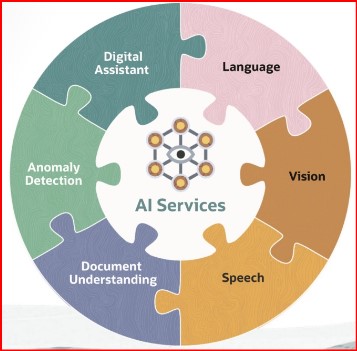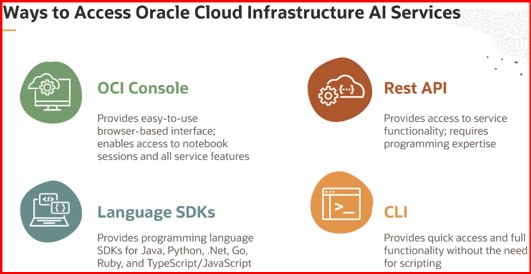Oracle Artificial Intelligence Services Overview
 Oracle Cloud Infrastructure(OCI) Artificial Intelligence (AI) Services Overview
Oracle Cloud Infrastructure(OCI) Artificial Intelligence (AI) Services Overview
In this article , we will focus on OCI AI services.
Business applications consume AI and ML services. The foundation of AI services and ML services is data. AI services contain pre-built models for specific uses. Some of the AI services are pre-trained, and some can be Additionally trained by the customer with their own data.
AI services can be consumed by calling the API for the service, passing in the data to be processed, and the service returns a result.
| There is no infrastructure to be managed for using AI services. |
OCI AI services
OCI AI services is a collection of services with pre-built machine learning models that make it easier for developers to build a variety of business applications. The models can also be custom trained for more accurate business results.
The different OCI AI services provided are given below .
- OCI language
- OCI vision
- OCI speech
- OCI document understanding
- OCI anomaly detection
- OCI digital assistant

OCI language – AI Service
OCI language allows you to perform sophisticated text analysis at scale. Using the pre-trained and custom models, you can process unstructured text to extract insights without data science expertise. Language services are provided by pre-trained models, custom models, and text translation. Pre-trained models include language detection, sentiment analysis, key phrase extraction, text classification, named entity recognition, and personal identifiable information detection.
OCI Vision – AI Service
Custom models can be trained for named entity recognition and text classification with domain specific data sets. In text translation, natural machine translation is used to translate text across numerous languages. Using OCI Vision, you can upload images to detect and classify objects in them.
Pre-trained models and custom models are supported. In image analysis, pre-trained models perform object detection, image classification, and optical character recognition(OCR). In Image analysis, custom models can perform custom object detection by detecting the location of custom objects in an image and providing a bounding box.
The custom image classification builds a model to identify objects and scene based features in an image.
The OCI speech – AI service
The OCI speech service is used to convert media files to readable texts that’s stored in JSON and SRT format. Speech enables you to easily convert media files containing human speech into highly exact text transcriptions.
OCI document understanding – AI Service
Using OCI document understanding, you can upload documents to detect and classify text and objects in them. You can process individual files or batches of documents. In optical character recognition (OCR), document understanding can detect and recognize text in a document. In text extraction, document understanding provides the word level and line level text. And the bounding box, coordinates of where the text is found.
In key value extraction, document understanding extracts a predefined list of key value pairs of information from receipts, invoices, passports, and driver IDs. In table extraction, document understanding extracts content in tabular format, maintaining the row and column relationship of cells. In document classification, the document understanding classifies documents into different types.
OCI Anomaly Detection – AI service
The OCI Anomaly Detection service is a service that analyzes large volume of multivariate or univariate time series data. The Anomaly Detection service increases the reliability of businesses by monitoring their critical assets and detecting anomalies early with high precision. Anomaly Detection is the identification of rare items, events, or observations in data that differ significantly from the expectation.
The Anomaly Detection service is designed to help with analyzing large amounts of data and identifying the anomalies at the earliest possible time with maximum accuracy. Different sectors, such as utility, oil and gas, transportation, manufacturing, telecommunications, banking, and insurance use anomaly detection service for their day to day activities.
OCI Digital Assistant – AI Service
Oracle Digital Assistant is a platform that allows you to create and deploy digital assistants, which are AI driven interfaces that help users accomplish a variety of tasks with natural language conversations. When a user engages with the Digital Assistant, the Digital Assistant evaluates the user input and routes the conversation to and from the appropriate skills.
Digital Assistant greets the user upon access. Upon user requests, list what it can do and provide entry points into the given skills. It routes explicit user requests to the appropriate skills. And it also handles interruptions to flows and disambiguation. It also handles requests to exit the bot. Thanks for listening.
Ways to Access OCI AI Services.
OCI AI services provide multiple methods for access. Below are the ways to access Oracle Cloud Infrastructure (OCI) Artificial Intelligence (A)) Services.
Method 1: OCI Console
The most common method is the OCI Console. The OCI Console provides an easy to use, browser based interface that enables access to notebook sessions and all the features of all the data science, as well as AI services.
Method 2: REST API
REST API. The REST API provides access to service functionality but requires programming expertise. And API reference is provided in the product documentation.
Method 3: Language SDKs
Language SDKs, OCI also provides programming language SDK for Java, Python, TypeScript, JavaScript, .Net, Go, and Ruby.
Method 4: CLI
The command line interface provides both quick access and full functionality without the need for scripting.
Summary for Accessing OCI AI Services can be seen in the below picture.

Source :
See also

